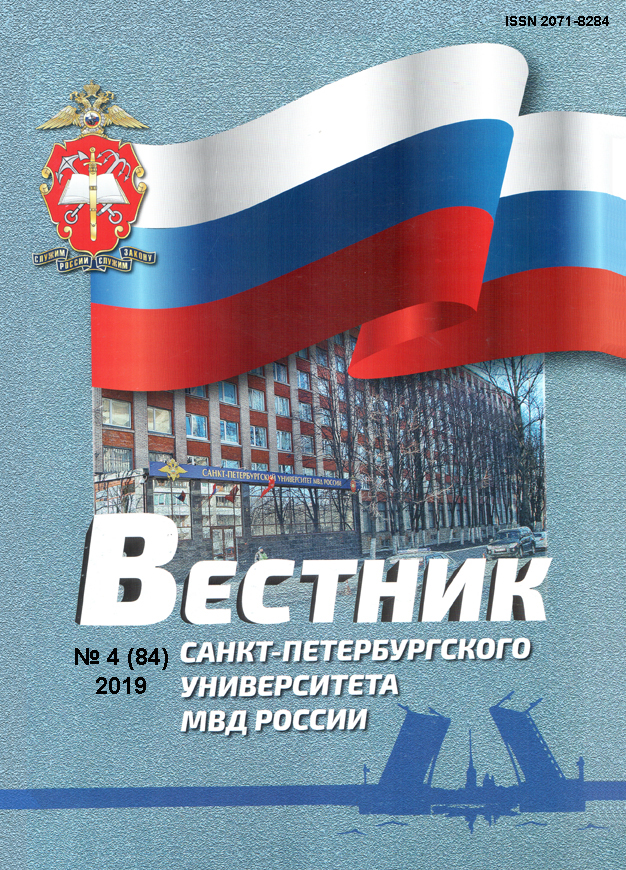Russian Federation
UDC 34
CSCSTI 10.07
The relevance of the topic of the study is due to the need to find an optimal model of police activity that meets the requirements and challenges of the present. The transformation of the public organization requires the comprehension of the current situation, new forms of theorizing and the development of new conceptual ideas. The growing importance of police systems in the context of globalization has been determined by a variety of law enforcement practices that requires critical analysis. A historiographic analysis of the problem of the use of predictive analytics in police activities showed that such experience from the theoretical and legal position was not reflected in the researches of Russian scientists. The object of the study was the police systems of foreign countries, where the predictive analytics became widespread and was the basis of the work of the police bodies. Predictive analytics (software that allows to predict crime) and the possibilities of its use in police activities is the subject of the research. A legal analysis of prognostic police activity, on the basis of which a new law enforcement model was developed, which already confirmed its effectiveness in the US, Great Britain, Germany, the Netherlands, China was the purpose of the research. The methodology of the study was drawn up by the scientific principles of dialectics, historicism and objectivity, based on the recognition of the variability in the ways of implementing the law enforcement function of the state in various national political and legal systems, as well as general scientific methods: analysis and synthesis, induction and deduction, analogue method, ascent from abstract to concrete, and private-scientific methods: legal comparativeness, formal-legal (dogmatic), methods of systemic and structural-functional analysis, methods of theoretical modeling and scientific forecasting. In the course of the research, the author have concluded that the use of predictive analytics in the police activity is a perspective direction of work, during which individuals and places with an increased risk of crime can be identified. Prognostic activity does not replace traditional methods and directions of police work, but strengthens them by applying advanced statistical models and algorithms with minimal use of budgetary funds. The police’s prognostic activity requires a new way of thinking, a high level of automation, and the expansion of technological capabilities of mass observation. Only under such conditions it is possible to create a police system that is able to meet the modern needs of society and effectively fulfill its tasks.
modern state, police system, innovations in police activity, models of police activity, prognostic activity of police, predictive analytics
1. Bentam I. Vvedenie v osnovaniya nravstvennosti i zakonodatel'stva. - Moskva: Istoriya politicheskoy mysli, 1998. - 416 s.
2. Dremlyuga R. I., Reshetnikov V. V. Pravovye aspekty primeneniya prediktivnoy analitiki v pravoohranitel'noy deyatel'nosti // Aziatsko-Tihookeanskiy region: ekonomika, politika, pravo. - 2018. - № 3. - S. 133-144.
3. Nizhnik N. S. Policeyskaya sistema - strukturno-funkcional'nyy element pravoohranitel'noy sistemy gosudarstva / 210 let MVD Rossii: istoriya i covremennost' : materialy Vserossiyskoy nauchno-prakticheskoy konferencii 21 sentyabrya 2012 goda. - Ch. 1. - Sankt-Peterburg: Sankt-Peterburgskiy universitet MVD Rossii, 2013. - S. 10-22.
4. Nizhnik N. S. Policeyskaya sistema kak element pravoohranitel'noy sistemy sovremennogo gosudarstva / Aktual'nye problemy prava i pravoprimenitel'noy deyatel'nosti na sovremennom etape : materialy Mezhdunarodnoy nauchno-prakticheskoy konferencii, 19-20 sentyabrya 2013 g. / pod obsch. red. V. A. Sosova. - Krasnodar: Izdatel'skiy dom «Yug», 2013. - S. 6-13.
5. Nizhnik N. S. Pravoohranitel'naya sistema gosudarstva: soderzhanie i organizacionnoe oformlenie // Pravo i gosudarstvo : problemy metodologii, teorii i istorii : vaterialy VIII Vserossiyskoy nauchno-prakticheskoy konferencii (17 maya 2019 g.) / god red L. V. Karnaushenko. - Krasnodar: Krasnodarskiy universitet MVD Rossii, 2019. - S. 40-47.
6. Chestnov I. L. Osnovaniya politiki policeyskoy deyatel'nosti / Rossiyskaya policiya: tri veka sluzheniya Otechestvu : materialy yubileynoy Mezhdunarodnoy nauchnoy konferencii, posvyaschennoy 300-letiyu rossiyskoy policii / pod red. N. S. Nizhnik. - Sankt-Peterburg: Sankt-Peterburgskiy universitet MVD Rossii, 2018. - S. 40-44.
7. Baraniuk S. Caught before the Act // New Scientist. - 2015. - Vol. 225. - P. 18-22.
8. Bennett M. L., Chan J. Algorithmic prediction in policing: Assumptions, evaluation, and accountability / Policing and Society. - 2016. - R. 806-822.
9. Bentham J. Théorie des Peines et des Récompenses (rédigée en français d’après les manuscrits de Bentham de 1775 par Étienne Dumont, et publiée pour la première fois à Londres en 1811). - Bruxelles: Société Belge de Librairie, 1840.
10. Brodeur J. P., Dupont B. Introduction essay: The role of knowledge and networks in policing. In: Williamson, T. (ed.), The Handbook of Knowledge-Based Policing: Current Conceptions and Future Directions. Chichester. - UK: John Wiley & Sons, 2008. - R. 22-25.
11. Bruner J. Acts of Meaning. - Cambridge: Harvard University Press, 1990. - 181 r.
12. Brunon-Ernst A. Le Panoptique des Pauvres: Bentham et la Réforme de l’Assistance en Angleterre. - Paris: Presses Sorbonne Nouvell, 2007. - 271 r.
13. Camacho-Collados M., Liberatore F. A decision support system for predictive police patrolling / Decision Support Systems. - 2015. - R. 25-37.
14. Caplan J. M., Kennedy L. M., Miller J. Risk Terrain Modeling: Brokering Criminological Theory and GIS methods for Crime Forecasting // Justice Quarterly, 2011. - Vol. 28. - No. 2. - R. 360-381.
15. Foucault M. Security, territory, population. In: Davidson, A. I. (ed.) // Lectures at the Collège de France, 1977-1978. - London, UK: Palgrave-Macmillan, 2007. - 417 r.
16. Friend Z. Predictive Policing: Using Technology to Reduce Crime / FBI Law Enforcement Bulletin. - Federal Bureau of Investigation, 2018. - P. 86-90.
17. Norton A. A. Predictive policing: The future of law enforcement in the Trinidad and Tobago police service (TTPS) // International Journal of Computer Applications. - 2013. - No. 62 (4). - R. 32-36.
18. Perry W. L. Predictive policing: The role of crime forecasting in law enforcement operations. - Santa Monica: Rand Corporation, 2013. - 145 r.
19. Ratcliffe J. H. The hotspot matrix: A framework for the spatio-temporal targeting of crime reduction // Police Practice and Research. - 2004. - No 5(1). - R. 5-23.
20. Smith L. D., Best L. A., Cylke V. A., Stubbs D. A. Psychology without p values: Data analysis at the turn of the 19-th century // American Psychologist. - 2000. -No 55(2). - R. 260-263.
21. Williams M. L., Burnap P., Sloan L. Crime sensing with big data: The affordances and limitations of using open source communications to estimate crime patterns // British Journal of Criminology. - 2016. - No 57. - R. 320-340.
22. Tasha J. Youstin et al. Assessing the Generalizability of the near repeat phenomenon // Criminal Justice and Behavior. - 2011. - No 38. - R. 1042-1063.














